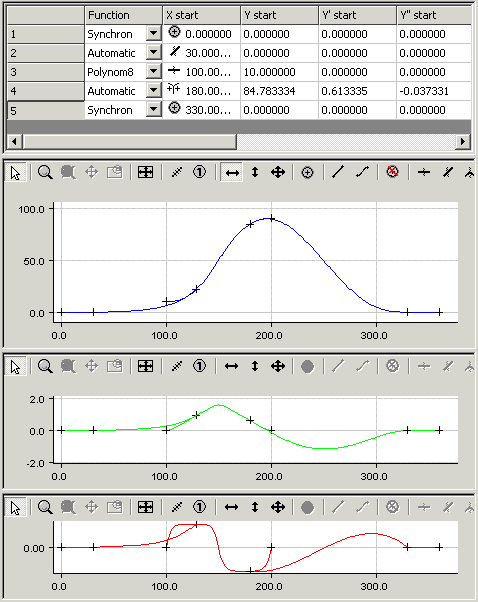Example 4
The procedure for creating a motion diagram is illustrated in this simple example.
The task:
The following slave motion is to be implemented for a rotation of the master axes from 0 to 360 degrees.
- A rest (stationary slave axis) between 0 and 30 degrees.
- Synchronization to a specified motion (from master position 100 and slave position 10 to the positions 200 and 90 respectively, with an eighth order polynomial motion function).
- A rest (stationary slave axis) between 300 and 360 degrees.
- In the tree structure, create a master and its corresponding slave via MOTION > Tables (see Introduction).
- After selecting Slave 1 in the tree structure, both the graphic window and the table window appear.
- In the graphic window, click the approximate positions of the points in the window using the Insert Point command.
The corresponding values will then be inserted into the table window.
- To turn the motion plan into a motion diagram, you now need to add some information.
- For the first, third and fifth sections we use the Synchronous Function command to specify by clicking with the mouse in the corresponding sections that a linear motion should take place there. In the second and fourth sections, the Automatic Function command is used to implement automatic adaptation to the boundary conditions.
- You can now use the move commands to manipulate the position of the points.
By right-clicking and selecting Select Graph 3 View, the velocity in the second graph window and the acceleration in the third graph window are displayed in addition to the slave position in the first graph window.
Using the Slide point command, and by selecting a point in the first half of the third section, the end point of the second section is placed on the function graph of the third. Using the Slide point command, and by selecting a point in the second half of the third section, the starting point of the fourth section is placed on the function graph of the third.
- Now set the master and slave positions in the table for the third section.
- Change the function type in the combo box to polynomial8.
- Then set the master and slave positions of the first and fifth sections.
With a vertical shift you can now move the end point of the third section or the start point of the fourth section to the third.
The first and second derivatives are automatically adjusted.
 | Cam plates with slide point cannot be transferred to the NC as a motion function. |


Select Save Slave... by right-clicking on the slave in the tree view to save the data of the motion diagram in an export file (*.xti). This data can be imported again under a master.